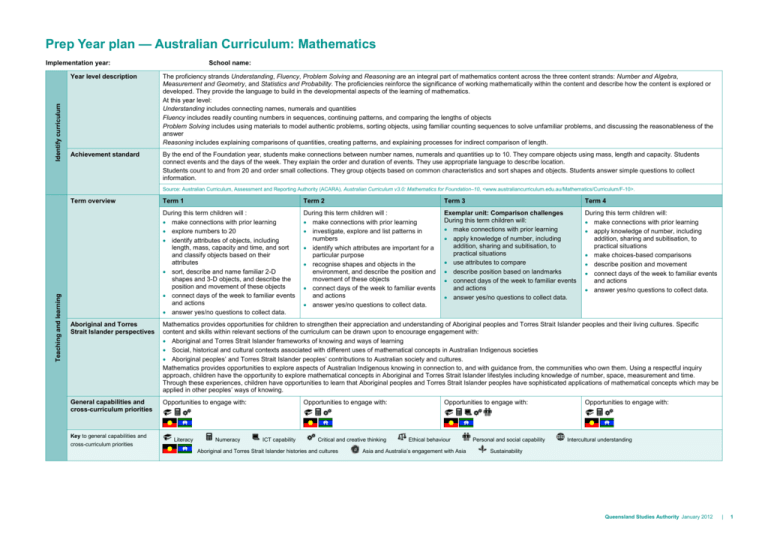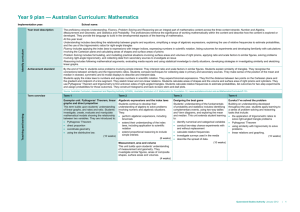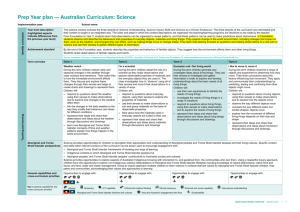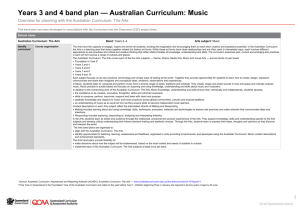Prep Year plan - Queensland Curriculum and Assessment Authority
advertisement

Prep Year plan — Australian Curriculum: Mathematics Identify curriculum Implementation year: School name: Year level description The proficiency strands Understanding, Fluency, Problem Solving and Reasoning are an integral part of mathematics content across the three content strands: Number and Algebra, Measurement and Geometry, and Statistics and Probability. The proficiencies reinforce the significance of working mathematically within the content and describe how the content is explored or developed. They provide the language to build in the developmental aspects of the learning of mathematics. At this year level: Understanding includes connecting names, numerals and quantities Fluency includes readily counting numbers in sequences, continuing patterns, and comparing the lengths of objects Problem Solving includes using materials to model authentic problems, sorting objects, using familiar counting sequences to solve unfamiliar problems, and discussing the reasonableness of the answer Reasoning includes explaining comparisons of quantities, creating patterns, and explaining processes for indirect comparison of length. Achievement standard By the end of the Foundation year, students make connections between number names, numerals and quantities up to 10. They compare objects using mass, length and capacity. Students connect events and the days of the week. They explain the order and duration of events. They use appropriate language to describe location. Students count to and from 20 and order small collections. They group objects based on common characteristics and sort shapes and objects. Students answer simple questions to collect information. Source: Australian Curriculum, Assessment and Reporting Authority (ACARA), Australian Curriculum v3.0: Mathematics for Foundation–10, <www.australiancurriculum.edu.au/Mathematics/Curriculum/F-10>. Teaching and learning Term overview Term 1 Term 2 Term 3 Term 4 During this term children will : make connections with prior learning explore numbers to 20 identify attributes of objects, including length, mass, capacity and time, and sort and classify objects based on their attributes sort, describe and name familiar 2-D shapes and 3-D objects, and describe the position and movement of these objects connect days of the week to familiar events and actions answer yes/no questions to collect data. During this term children will : make connections with prior learning investigate, explore and list patterns in numbers identify which attributes are important for a particular purpose recognise shapes and objects in the environment, and describe the position and movement of these objects connect days of the week to familiar events and actions answer yes/no questions to collect data. Exemplar unit: Comparison challenges During this term children will: make connections with prior learning apply knowledge of number, including addition, sharing and subitisation, to practical situations use attributes to compare describe position based on landmarks connect days of the week to familiar events and actions answer yes/no questions to collect data. During this term children will: make connections with prior learning apply knowledge of number, including addition, sharing and subitisation, to practical situations make choices-based comparisons describe position and movement connect days of the week to familiar events and actions answer yes/no questions to collect data. Aboriginal and Torres Strait Islander perspectives Mathematics provides opportunities for children to strengthen their appreciation and understanding of Aboriginal peoples and Torres Strait Islander peoples and their living cultures. Specific content and skills within relevant sections of the curriculum can be drawn upon to encourage engagement with: Aboriginal and Torres Strait Islander frameworks of knowing and ways of learning Social, historical and cultural contexts associated with different uses of mathematical concepts in Australian Indigenous societies Aboriginal peoples’ and Torres Strait Islander peoples’ contributions to Australian society and cultures. Mathematics provides opportunities to explore aspects of Australian Indigenous knowing in connection to, and with guidance from, the communities who own them. Using a respectful inquiry approach, children have the opportunity to explore mathematical concepts in Aboriginal and Torres Strait Islander lifestyles including knowledge of number, space, measurement and time. Through these experiences, children have opportunities to learn that Aboriginal peoples and Torres Strait Islander peoples have sophisticated applications of mathematical concepts which may be applied in other peoples’ ways of knowing. General capabilities and cross-curriculum priorities Opportunities to engage with: Key to general capabilities and cross-curriculum priorities Literacy Numeracy Opportunities to engage with: ICT capability Critical and creative thinking Aboriginal and Torres Strait Islander histories and cultures Opportunities to engage with: Ethical behaviour Asia and Australia’s engagement with Asia Personal and social capability Opportunities to engage with: Intercultural understanding Sustainability Queensland Studies Authority January 2012 | 1 Develop assessment Assessment For advice and guidelines on assessment, see www.qsa.qld.edu.au An assessment folio is a targeted collection of a child’s work for ongoing review and analysis, and for reporting a child’s achievement and progress at a point in time. Administrators and teachers determine the evidence that will be collected to demonstrate a pattern of achievement within the child’s learning across the Australian Curriculum and the remaining Queensland learning areas, where applicable. The assessment folio is a representative selection of evidence of the child’s learning in relation to the achievement standard for each learning area and it: ensures there are multiple opportunities to demonstrate the elements of the achievement standard and to demonstrate patterns within the evidence includes evidence compiled over time from a variety of quality early years assessment techniques and across a range of teaching and learning contexts considers the Year-level requirements and the school’s context ensures evidence of children’s learning is collected over a timespan that suits reporting and moderation processes for the purpose of twice-yearly reporting. The assessment folio may include: notes of conversations with children, e.g. spoken/signed: discussions in pairs about a poem anecdotal records, e.g. spoken/signed: class discussions about illustrations, images or imaginative texts personalised checklists with comments, e.g. written: one or more simple sentences to re-tell events images or recordings — photographs, video or audio recordings, e.g. multimodal: short statements using persuasive language and pictorial representations objects or artefacts that children develop or make, e.g. written: short texts using words, sentences, capital letters and full stops notes of discussions with other partners, e.g. spoken/signed: discussions in reading groups about characters and main events in imaginative texts oral questioning, e.g. spoken/signed: questions about shared reading. Other assessment techniques: visual diary, e.g. multimodal: photos/images and collaboratively produced annotations of dramatic performances annotated photo story, e.g. multimodal: informative texts collaboratively produced to record key ideas and visual features digital book discussion, e.g. multimodal: recounts and discussions of familiar texts interview, e.g. spoken/signed: interviews about short viewed texts to make connections to child’s personal experiences. The Term 3 unit overview provides further examples of unit-specific focused assessment. The Term 3 unit overview provides further examples of unit-specific focused assessment. Mathematical investigation (Demonstration) Children are given a series of challenges with different objects to measure using direct and indirect means of comparison. Challenges are performed across the term to check for understanding of the concepts as they are developed. Challenges reflect direct and indirect comparisons. The Term 3 unit overview provides further examples of unit-specific focused assessment. Make judgments and use feedback The assessment package Pick a package in the QSA Assessment Bank could be used as assessment in this unit. 2 | Moderation Teachers moderate and validate judgments about children’s learning progress to ensure consistency of judgment when matching evidence in an assessment folio to a standard or a phase descriptor. A moderation process may involve teachers sharing a sample range of assessment folios representing each level of the P–2 reporting framework in each of the learning areas. Teachers then discuss and match the samples to a level of achievement and apply an on-balance judgment to the class’s remaining assessment folios. School-based moderation processes can be applied to Australian Curriculum learning areas and remaining Queensland learning areas where the Australian Curriculum is not yet available. Prep Year plan Australian Curriculum: Mathematics Prep Mathematics: review for balance and coverage of content descriptions Number and Algebra 1 2 3 4 Number and place value Measurement and Geometry 1 2 3 4 Using units of measurement Establish understanding of the language and processes of counting by naming numbers in sequences, initially to and from 20, moving from any starting point (ACMNA001) Connect number names, numerals and quantities, including zero, initially up to 10 and then beyond (ACMNA002) Subitise small collections of objects (ACMNA003) Shape Compare, order and make correspondences between collections, initially to 20, and explain reasoning (ACMNA289) Sort, describe and name familiar two-dimensional shapes and three-dimensional objects in the environment (ACMMG009) Represent practical situations to model addition and sharing (ACMNA004) Location and transformation 1 2 3 4 Data representation and interpretation Use direct and indirect comparisons to decide which is longer, heavier or holds more, and explain reasoning in everyday language (ACMMG006) Compare and order the duration of events using the everyday language of time (ACMMG007) Connect days of the week to familiar events and actions (ACMMG008) Describe position and movement (ACMMG010) Statistics and Probability Answer yes/no questions to collect information (ACMSP011) Patterns and algebra Sort and classify familiar objects and explain the basis for these classifications. Copy, continue and create patterns with objects and drawings (ACMNA005) Source: Australian Curriculum, Assessment and Reporting Authority (ACARA), Australian Curriculum v3.0: Mathematics for Foundation–10, <www.australiancurriculum.edu.au/Mathematics/Curriculum/F-10>. Queensland Studies Authority January 2012 | 3







